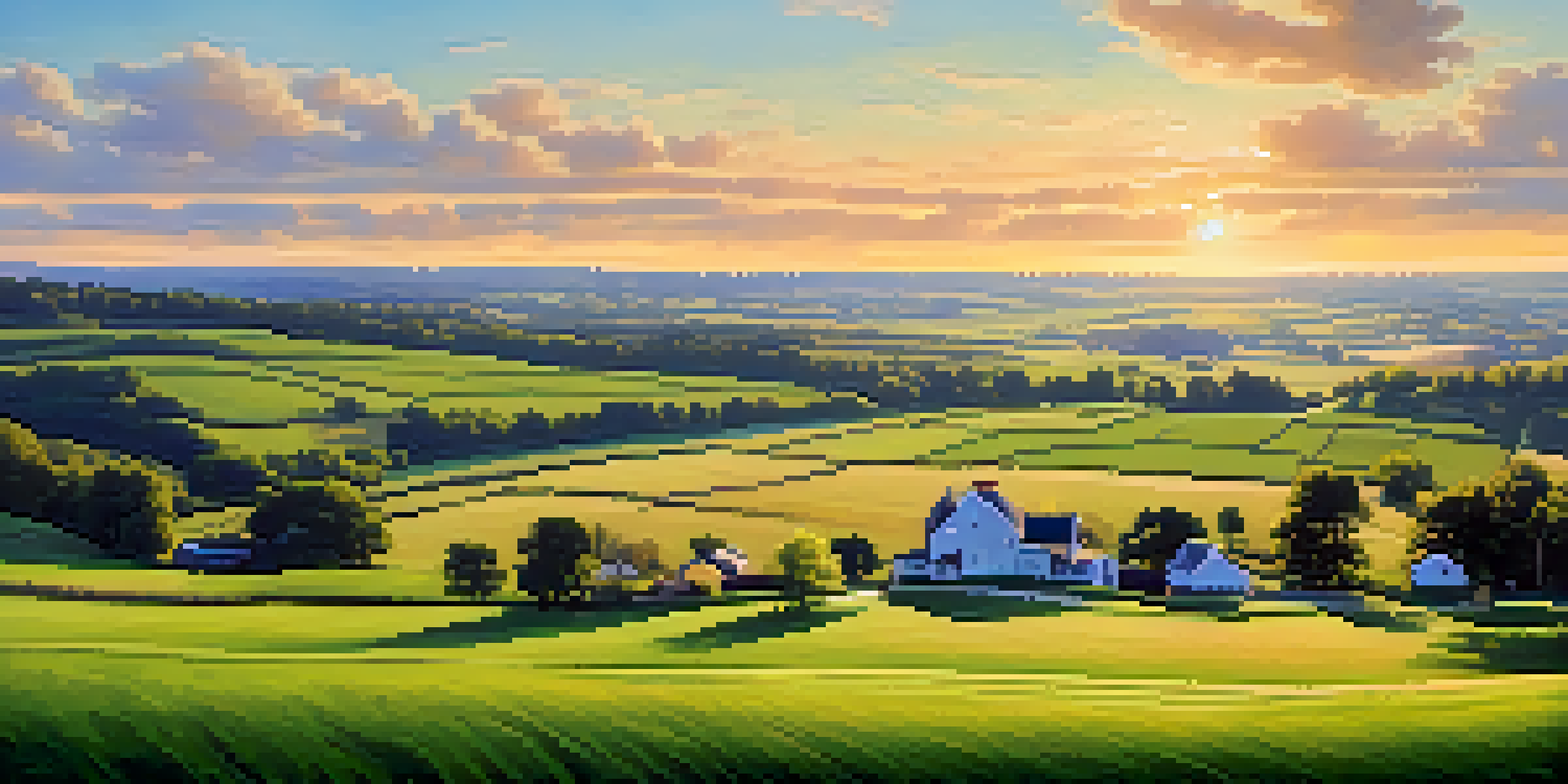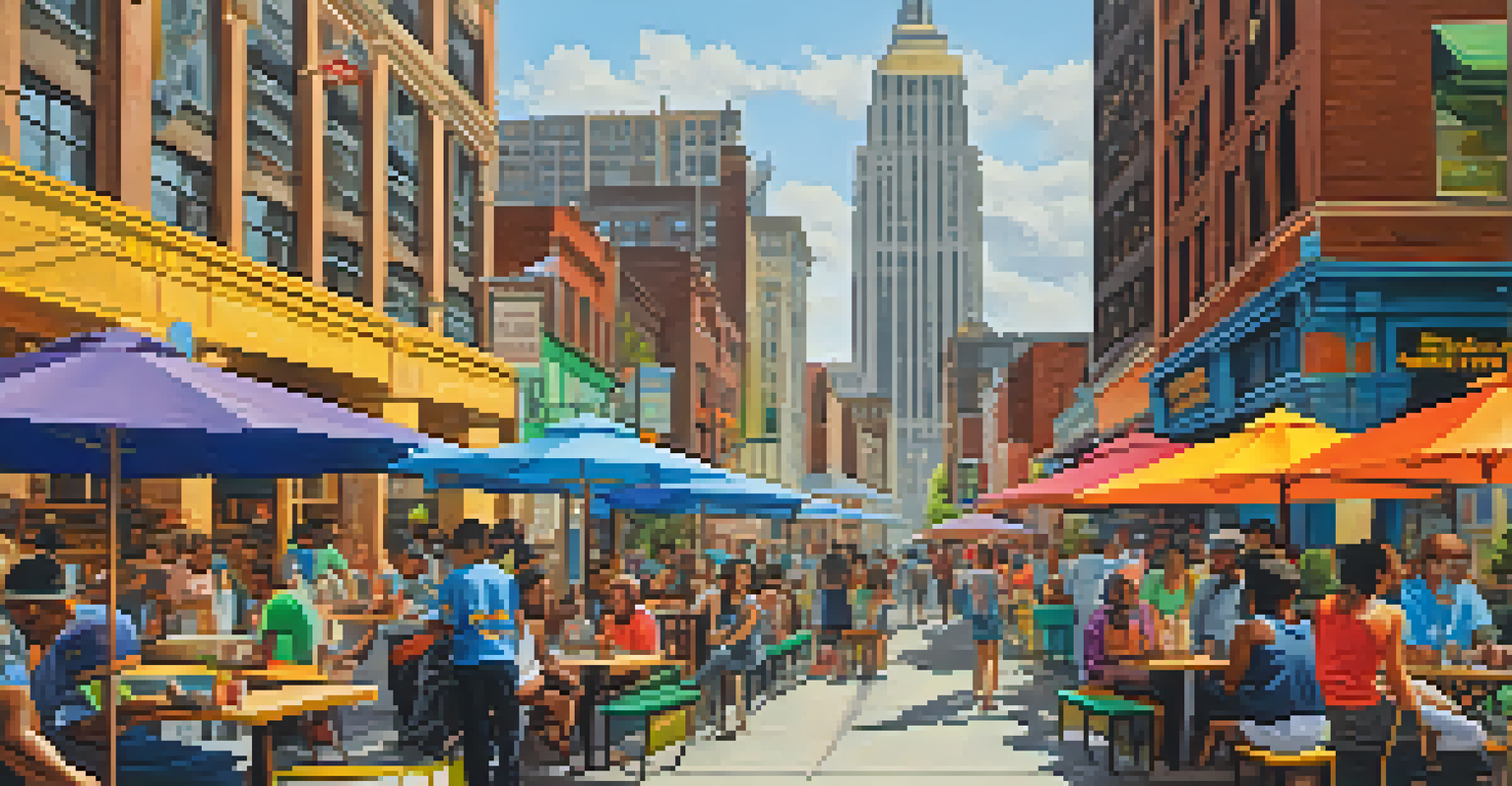Urban and Rural Geography: The Landscape of New Jersey

An Overview of New Jersey's Geography and Its Regions
New Jersey, often called the Garden State, is a unique blend of urban and rural landscapes. This small yet densely populated state boasts a variety of geographical features, from bustling cities to serene farmlands. Understanding its geography is essential for appreciating how the state's regions interact and influence each other.
New Jersey is a state of mind, and it is a place where the urban and rural coexist beautifully.
The state can be broadly divided into two main areas: urban and rural. Urban regions, such as Newark and Jersey City, are characterized by high population density and a plethora of economic activities. In contrast, rural areas, particularly in the western and southern parts, feature wide-open spaces, agricultural land, and charming small towns.
This duality in geography reflects not only the physical landscape but also the cultural and social dynamics of New Jersey. The coexistence of urban and rural settings creates a rich tapestry of experiences that is unique to the state.
Urban New Jersey: A Hub of Activity and Diversity
The urban landscape of New Jersey is vibrant and diverse, with cities that are teeming with life and culture. Newark, for example, serves as the state's largest city and is a melting pot of communities, offering a variety of dining, arts, and entertainment options. Public transportation makes it easy for residents to navigate the city and connect with New York City, enhancing its appeal as an urban center.

Urban areas in New Jersey are also economic powerhouses, with numerous industries ranging from finance to technology. The proximity to major metropolitan areas allows these cities to thrive economically, attracting individuals and families seeking job opportunities. This influx of people contributes to a dynamic urban culture that continues to evolve.
Urban and Rural Coexistence
New Jersey's geography features a unique interplay between bustling urban centers and serene rural landscapes, creating diverse experiences.
While cities like Hoboken and Camden represent modern urbanization, they also face challenges such as housing affordability and environmental concerns. Balancing growth with sustainability is crucial for maintaining the quality of life in these urban environments.
Rural New Jersey: A Retreat into Nature and Tradition
In stark contrast to its urban counterparts, rural New Jersey offers a tranquil escape filled with natural beauty and traditional charm. Regions such as Sussex County and parts of Burlington County are known for their picturesque landscapes, including rolling hills, forests, and farms. These areas provide a much-needed respite from the hustle and bustle of city life.
The essence of New Jersey is found in its diversity—by embracing both the city lights and the quiet fields, we find our true strength.
Agriculture plays a significant role in rural New Jersey, with many farms producing a variety of crops and livestock products. This agricultural heritage is celebrated through numerous farmers' markets and local festivals, allowing residents and visitors to connect with the land and its bounty. The commitment to preserving open space is also evident in the state's land use policies.
The rural lifestyle fosters a strong sense of community, with residents often knowing their neighbors and participating in local events. This tight-knit atmosphere creates a welcoming environment that contrasts sharply with the fast-paced urban experience.
The Interplay Between Urban and Rural Areas
The relationship between urban and rural areas in New Jersey is a fascinating one, marked by both cooperation and tension. Urban centers often rely on rural regions for food production, recreational spaces, and natural resources, while rural areas benefit from the economic opportunities provided by nearby cities. This interconnectedness is vital for the overall health of the state's economy and environment.
Challenges can arise, however, as urban expansion encroaches on rural land. As cities grow, there is often pressure to develop agricultural areas for housing and commercial projects. This can lead to conflicts over land use, highlighting the importance of sustainable planning that considers the needs of both urban and rural communities.
Cultural Vibrancy in Diversity
The rich cultural tapestry of New Jersey is shaped by both its urban diversity and rural traditions, fostering creativity and community.
Despite these challenges, many initiatives aim to bridge the gap between urban and rural New Jersey. Programs that promote local farming, sustainable development, and green spaces help foster a sense of unity and shared purpose among residents.
Transportation: Connecting Urban and Rural Landscapes
Transportation infrastructure plays a crucial role in linking New Jersey's urban and rural areas. The state boasts an extensive network of highways, railways, and public transit options that facilitate movement and commerce. For example, the New Jersey Transit system connects commuters from rural towns to urban jobs, ensuring that residents can access opportunities across the state.
Moreover, the accessibility of rural areas to urban centers enhances tourism, as visitors flock to experience the natural beauty and recreational activities available outside the cities. Hiking, biking, and agritourism are just a few examples of how rural New Jersey attracts urban dwellers looking for a weekend getaway.
However, the reliance on transportation can lead to challenges such as traffic congestion and environmental concerns. As more people commute between urban and rural areas, addressing these issues through sustainable transport options becomes increasingly important.
Cultural Influences Shaping Urban and Rural New Jersey
Cultural influences play a significant role in defining the character of both urban and rural New Jersey. In urban areas, the diverse population contributes to a rich tapestry of traditions, cuisines, and festivals. Cities like Paterson and Elizabeth boast vibrant immigrant communities that celebrate their heritage through art, music, and food, creating a dynamic cultural scene.
Conversely, rural areas often emphasize tradition and community values, reflecting a slower-paced lifestyle. Local fairs, agricultural shows, and craft festivals showcase the talents of residents while preserving the region's history and customs. This cultural exchange between urban and rural settings enriches the state's identity.
Sustainable Future Planning
Balancing growth with preservation is essential for New Jersey's future, ensuring that both urban and rural areas thrive together.
The blending of these cultural influences fosters a unique atmosphere that encourages creativity and innovation. As urban and rural areas continue to interact and influence one another, they create a more vibrant, inclusive New Jersey.
The Future of New Jersey's Urban and Rural Landscapes
As New Jersey moves forward, the future of its urban and rural landscapes will depend on careful planning and collaboration. With ongoing population growth and urban sprawl, addressing the challenges of sustainability, infrastructure, and community development is essential. Finding a balance between growth and preservation will be key to maintaining the state's character.
Innovative solutions, such as smart growth initiatives and green building practices, can help mitigate the impacts of urbanization on rural areas. By promoting sustainable practices, New Jersey can create a more resilient environment that benefits both urban and rural residents.

Ultimately, the future of New Jersey's geography will be shaped by its people. By fostering a sense of connection and understanding between urban and rural communities, the state can continue to thrive as a place where diverse landscapes coexist harmoniously.